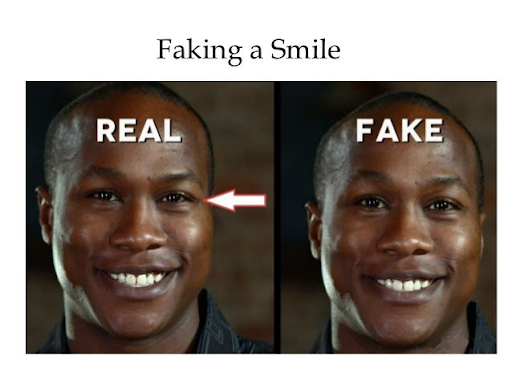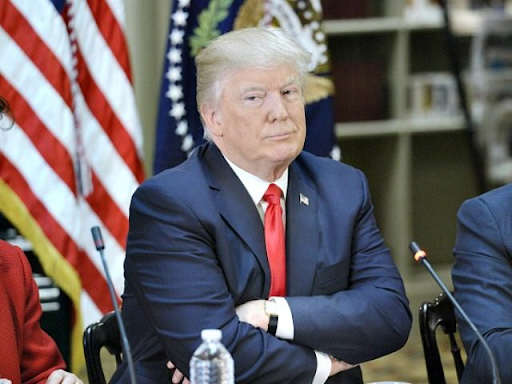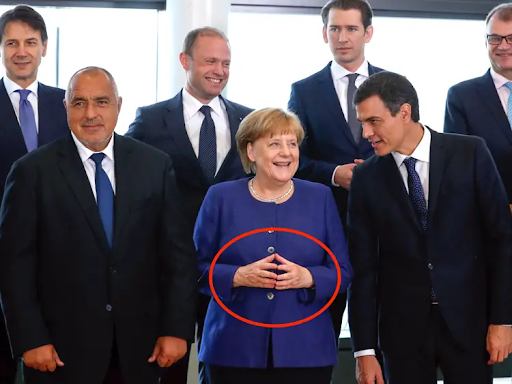5 Body Language Examples For Managers: How To Build Trust
What’s the difference between a real and a fake smile? Why is it helpful to mirror body language? What are the signs that your employees aren’t feeling at ease with the way you communicate? Keep reading to find out the answers.
The CEO of a big company is delivering a speech at a leadership conference. He’s a great public speaker. It’s evident by how the audience hangs on his every word.
But when he finishes, he crosses his arms in front of his chest and says:
“I’m open to questions. Please ask me anything.”
The audience that was so attentive is now struggling to come up with questions.
What happened? How could this body language have had such an impact?
Good communication is not just about the words we use. In fact, 65% of conversations between two people will be made up of body language cues alone.
Ever heard of the saying that our body language gives us away?
You can say one thing but be betrayed just as easily by raising an eyebrow or curling your lips.
In the workplace, and especially as a manager, understanding body language is a sure-fire way to facilitate communication between you and your peers.
Plus, seeing these body language examples will help you develop an awareness of the people around you.
It will also help you become aware of the messages you convey to others, and how to optimize your communication style, depending on what leadership styles are in your management toolkit.
We’re going to provide you with body language examples today that will teach you how to:
- Spot common body language
- Optimize how you convey messages
- Improve your meetings
- Create meaningful relationships between you and your employees
What is body language?
Body language is how we convey messages through non-verbal cues. But did you know that there are 700,000 forms of body language?
Experts study this area like we study real languages, with a huge amount of vocabulary and nuances.
Body language is about facial expressions, gestures, postures, and hand movements.
And the most important thing to remember?
Body language can be either conscious or subconscious. Which suggests you might get a lot of meaning out of something that the person you’re communicating with doesn’t even know they’re conveying.
Just watch how this FBI agent can catch people out on crimes simply by reading their body language:
Body language examples to improve your communication as a manager
At Krauthammer, we strongly believe in the power of simulating scenarios. Our participants get to play out unique situations so that when the time comes they have fallback behaviors that have already been trained.
Today, we want to provide you with tried and tested body language examples so you can see these at work. And, hopefully, be able to spot them yourself as you carry out your role as a manager.
1. Real smile or fake smile?

This is the scenario: You’ve explained the new business strategy and some of your team members are smiling.
That’s a good sign – looks like you have buy-in, right?
Unfortunately, that might not be true. People can smile out of politeness or to hide what they are actually thinking and feeling.
Smiling is also a learned behavior and a cultural habit.
How do you differentiate between a real smile and a fake one?
A real smile reaches your eyes showing wrinkles around their corners. This movement around the eyes is extremely difficult to fake and tells you the truth.
Tip for this body language example:
If it’s a fake smile then it might be an idea to address the other person directly asking for their feedback.
Alternatively, you can also try to convey your message better. Research shows that most people instantly and unconsciously recognize the sincerity of your smile by simply looking at the top half of your face.
This is one of those times where you shouldn't fake it to make it! And another time where it pays to be observant so you can spot:
- Fake smiles (to take action) vs.
- Real smiles (to validate your communication).
2. Mirroring movements?

Imagine this: You’re in a meeting with someone and you notice that every time you cross or uncross your legs your partner does the same.
This kind of mirroring of body language is actually a good sign. Mirroring body language is something we do unconsciously when we feel engaged with the other person, if this is done;
- Respectfully
- Discreetly
This body language example is especially useful when you’re negotiating. People respond more favorably to those who show body postures and speech patterns similar to their own.
If you’re in a sales pitch and your prospect subconsciously matches your body language this can be a sign of rapport.
Tip for this body language example:
If you want to establish a connection with a new person, mirror their posture, gestures, seating position, even tone or inflection.
Mirroring team members’ facial expressions and body positions instantly communicates empathy (we often do it automatically).
It signals that you understand the feelings of the people around you and that you take those feelings into account.
But remember: This should be as discreet as it is natural. It’s about subtle adjustments to your body language that should eventually come across as natural.
3. Making people anxious?

A team member is struggling with an important project and you have a project session scheduled. During the conversation you observe the following behavior:
- Very few facial expressions
- Downcast eyes to avoid direct contact
- Hands and arms close to the body
- The body turned away from you
Spotting these signs is important. You could be making your team member feel anxious.
Tip for this body language example:
If your employee feels defensive and ill at ease, you should probably change your approach.
How?
- Ask open questions
- Rephrase your message
- Adopt a firm but not intimidating tone of voice so that the other person is more receptive to your feedback
Also, verify the way you sit; does your body posture show that you are open to providing support?
All of these body language examples should be as easy to spot as they are to implement yourself. Remember that half of these cues are unconscious – your team will be looking at you to build this environment of trust and empathy.
And it starts with how you express yourself!
4. Showing resistance?
Another scenario for you: You have a cost issue with a supplier which needs to be fixed.
During the negotiation, their account manager is crossing his arms signaling that they are closed off and not willing to accept your proposal.
For their book “How to Read a Person Like a Book” Gerard Nierenberg and Henry Calero* videotaped more than 2,000 negotiations. Not a single negotiation ended in an agreement when one of the parties involved had their arms crossed while negotiating.

Tip for this body language example:
If your intent in a negotiation is to say “no” then go ahead and cross your arms. You can also do this when you have indicated your final number or a deal-breaker clause.
But in situations other than negotiations, it’s better to avoid this posture. No one wants to talk to someone who has already made up their mind and isn’t open to an exchange.
So uncross your arms and be ready to listen to others' points of view unless it’s your imperative to show that you are not at all on the same wavelength.
5. Boring presentation?
You’re giving a presentation. No doubt, you want everyone to be attentive and fully engaged.
But after five minutes you already notice that people slump in their chairs, fidget with objects, and scribble on paper. Some even start talking. The nerve!
All the signs point to it: Your audience is bored.
Tip for this body language example:
In this case, you should react. One way to do this is by initiating a discussion to actively involve people.
After that, continue with the key points of your presentation. If you know up front that you are going to deal with an audience that gets easily bored, then prepare your presentation in small units and try to engage people after each unit in some short activity.
If you want to find out more about what you are saying with your body language, videotape yourself having a conversation with someone.
Ask yourself “what would I think about someone who looks, talks, and acts as I do?”
Then, adjust your behavior and body language accordingly!
If you feel like these simulations aren’t enough, Krauthammer offers real-time training situations where you can play every scenario out.
We strongly believe there’s nothing like good old role-playing to help you prepare. Especially when you’re dealing with people and body language, it’s more helpful to see these in action.
Being a strong leader in the 21st century is about giving the air of confidence. So that your team can trust you to take them into the future of work.
Here’s how you do this through your body language.
Body language example: How to adopt a confident posture
- Stand tall, don’t slouch. Otherwise, you’ll seem tired and lacking in energy.
- A relaxed smile creates a positive atmosphere. A frown makes you appear tense and standoffish.
- Make eye contact with everyone. Avoid looking at just one person.
- Do you scratch your nose, your ear, or your eyes when speaking? Avoid gestures like pointing fingers or rubbing your hands together. You will appear as being nervous and distracted.
- Steepling your hands is a sign of high confidence.

Source: Angela Merkel steepling her hands together.
- Rubbing the chin or placing the hand under the chin with one or two fingers on the cheek is a sign of contemplation or evaluation.
Conclusion
These body language examples just touch the tip of the iceberg when it comes to understanding body language in a managerial position.
There’s so much more at play here. From gestures to facial expressions, to hand positions: It’s a whole world waiting for you to understand.
And why would you?
In short, understanding body language will not only help you cultivate an environment of trust and empathy. It will also make you appear more confident, and garner the trust of your team.
When your mindset is genuine and your attitude is right, even your subconscious body language will follow suit and instill trust. At Krauthammer, this is the end goal: training people to be confident inside and out.
Future-proofing your management style
These new leadership and management challenges may be frustrating to handle all at once.
But they also provide a unique opportunity for you to adapt your leadership approach now to increase the chances of success tomorrow.
We may be living through a highly challenging decade. But at Krauthammer, we strongly believe that leaders can learn from it, grow from it, and use it as a driving force behind their excellence.

.png?width=600&name=The%20Ultimate%20Guide%20to%20Adapting%20Your%20Sales%20Process%20to%20Incorporate%20Remote%20Sales%20and%20Energise%20Your%20Team%20to%20Boost%20Results%20(1).png)